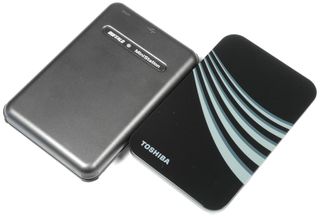Convenience Storage By Buffalo And Toshiba

Data Mobilization By Buffalo And Toshiba
The market for external storage products is divided into drives based on 3.5” hard drives, and others utilizing 2.5” or even 1.8” disks to store data. Obviously, all of them depend on available capacities in the hard drive segment, as Flash-based storage products are still limited to 32 GB, with 64 GB coming soon—clearly not enough for backup and archiving purpose. Of course, 3.5” external drives are hard to make truly portable, while 1.8” based drives increase cost per gigabyte for the sake of mobility. Hence we looked at two high-capacity 2.5” hard drives by Buffalo and Toshiba.
It appears to be difficult to find meaningful differences among obviously similar products. Both are similar in size, Toshiba is somewhat lighter, Buffalo offers higher capacity (500 GB vs. 320 GB). Both come bundled with backup software and they are available at similar prices. There are differences in performance (although these only matter for enthusiasts), in exterior quality, and in features. The latter is an issue we’ll discuss at the end of this comparison.
Power consumption has become increasingly important, as users are becoming aware of efficiency for different reasons, but mainly because of energy costs. In the case of portable 2.5” hard drives, all of these have to be able to run on USB 2.0 interfaces, limiting the power requirements to 500 mA at 5 volts. Theoretically, this limits the peak power consumption of portable drives to 2.5 watts. In practice, interfaces are capable of providing a bit more, so most portable 2.5” hard drives can run on only a single USB 2.0 connection. Some, however, like Buffalo’s Mini Station Turbo USB, may require more power still.
Let’s look at the features and performance of the two portable storage flagships by Buffalo and Toshiba.

Stay on the Cutting Edge
Join the experts who read Tom's Hardware for the inside track on enthusiast PC tech news — and have for over 25 years. We'll send breaking news and in-depth reviews of CPUs, GPUs, AI, maker hardware and more straight to your inbox.
Current page: Data Mobilization By Buffalo And Toshiba
Next Page Buffalo Mini Station TurboUSB, 500 GBMost Popular

